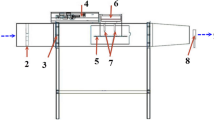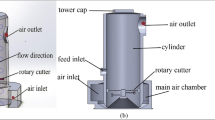The simulation of heat transfer for contact drying of fibrous and high-moisture materials with the use of variable heat supply was carried out in order to determine the rational production parameters of the roller dryer and increase the energy efficiency of the technological line. For drying materials, analytical dependences for determining the heat flux, the intensity of the heat carrier consumption per time unit, and the intensity of the thermal effect under conditions of variable heat supply are proposed. Based on the obtained model of heat transfer under variable thermal effect, the calculation of the contact drying process for a roller dryer was performed.




Similar content being viewed by others
References
S. T. Antipov, G. V. Kalashnikov, A. N., Ostrikov, and V. A. Panfilov, Equipment for Conducting Heat and Mass Transfer Processes of Food Technologies [in Russian], Lan’, St. Petersburg (2020).
G. B. Kalashnikov and O. V. Chernyaev, “Energy-efficient combination convective drying of disperse materials,” Khim. Volokna, No. 4 (51), 70-73 (2019).
M. Zhang, H. Chen, A. S. Mujumdar, et al., “Recent developments in high-quality drying of vegetables, fruits, and aquatic products,” Cr. Rev. Food Sci., 57, No. 6, 1239-1255 (2017).
V. A. Panfilov, S. T. Antipov, and A. N. Ostrikov, Equipment for Conducting Mechanical and Hydromechanical Processes of Food Technologies [in Russian], Lan’, St. Petersburg (2020).
A. Menon, V. Stojceska, and S. A. Tassou, “A systematic review on the recent advances of the energy efficiency improvements in non-conventional food drying technologies,” Trends Food Sci. Tech., 100, 67-76 (2020).
Y. Wei, J. Hua, and X. Ding, “A mathematical model for simulating heat and moisture transfer within porous cotton fabric drying inside the domestic air-vented drum dryer,” J. Text. I., 108, No. 6, 1074-1084 (2017).
O. Fudym, C. C. Gee, D. Lecomte, and B. Ladevie, “Drying kinetics and heat flux in thin-layer conductive drying,” Intern. Commun. Heat Mass, 30, No. 3, 333-348 (2003).
S. Prvulovic, D. Tolmac, M. Lambic, et al., “Experimental and theoretical investigation of drying technology and heat transfer on the contact cylindrical dryer,” Mater. Tehnol., 46, No. 2, 115-121 (2012).
G. Kalashnikov, “Basic patterns of moisture absorption during the hydrothermal treatment of fibrous and dispersed materials with the periodic heat and moisture supply,” Fibre Chem., 54, No. 1, 40-43 (2022).
D. Ma, A. Li, L. Zhang, et al., “Mechanical compression assisted conductive drying of thin-film dewatered sewage sludge: Process performance, heat and mass transfer behavior,” Waste Manage., 126, 41-51 (2021).
A. G. Demkin, F. S. Yugai, and S. A. Kochergin, “Combined convective-conductive heat transfer furnaces for drying and calcining aluminum fluoride,” Khim. Tekhn., No. 3, 30-31 (2017).
E. S. Bunin, G. V. Kalashnikov, and S. V. Makeev, “Thermodynamic assessment of the phenomena of heat and mass transfer for energy-technological systems production of groats concentrates,” IOP C. Ser. Earth Env., 640, No. 2, 022063 (2021).
Ya. Shargut and R. Petela, Exergy [in Russian], Energiya, Moscow (1968).
M. Intelvi, A. Picado, and J. Martínez, “Contact drying simulation of particulate materials: A comprehensive approach,” Int. J. Chem. Mol. Nucl. Mater., 5, No. 11, 958-965 (2011).
L. Hoekstra, P. Vonk, and L. A. Hulshof, “Modeling the scale-up of contact drying processes,” Org. Process Res. Dev., 10, No. 3, 409-416 (2006).
T. Metzger, M. Kwapinska, M. Peglow, et al., “Modern modelling methods in drying,” Transport Porous Med., 66, No. 1, 103-120 (2007).
Ya. Yu. Kolyano, T. S. Sass, and E. G. Ivanik, “Simulation of conductive drying of polygraphic materials of a capillary-porous colloid structure,” Inzh. Fiz. Zh., 91, No. 5, 1231-1241 (2018).
M. Intelvi, A. Picado, and J. Martínez, “Contact drying simulation of particulate materials: A comprehensive approach,” Int. J. Chem. Mol. Nucl. Mater., 5, No. 11, 958-965 (2011).
E. K. Sahni and B. Chaudhuri, “Contact drying: A review of experimental and mechanistic modeling approaches,” Int. J. Pharm., 434, No. 1-2, 334-348 (2012).
Z. Pakowski and A. S. Mujumdar, “Basic process calculations in drying,” In: Handbook of Industrial Drying, CRC Press, Boca Raton (2020).
K. F. Pavlov, P. G. Romankov, and A. A. Noskov, Examples and Problems in the Course of Processes and Apparatuses of Chemical Technology [in Russian], RusMediaKonsalt, Moscow (2004).
Author information
Authors and Affiliations
Corresponding author
Additional information
Translated from Khimicheskie Volokna, No. 1, pp. 3-7, January-February, 2023.
Rights and permissions
Springer Nature or its licensor (e.g. a society or other partner) holds exclusive rights to this article under a publishing agreement with the author(s) or other rightsholder(s); author self-archiving of the accepted manuscript version of this article is solely governed by the terms of such publishing agreement and applicable law.
About this article
Cite this article
Kalashnikov, G.V. Simulation of Heat Transfer for Contact Drying of Fibrous and High-Moisture Materials with Variable Heat Supply. Fibre Chem 55, 1–5 (2023). https://doi.org/10.1007/s10692-023-10416-8
Published:
Issue Date:
DOI: https://doi.org/10.1007/s10692-023-10416-8




